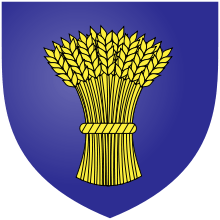Scrope v Grosvenor

Scrope v Grosvenor (1389) was one of the earliest heraldic law cases brought in England. The case resulted from the fact that two different families were using the same undifferenced coat of arms. In the 12th and 13th centuries, the composition of coats of arms was very simple. Most shields consisted of only one charge and two tinctures, and there were times when two families bore the same coat of arms in the same jurisdiction. In the fourteenth century, though, cases of two unrelated families bearing the same coat of arms became less tolerated. When this happened, the monarch was usually called on to make a decision.
The case and the judgment
In 1385, King Richard II of England invaded Scotland with his army. During this invasion, two of the king’s knights realized that they were using the same coat of arms. Richard Scrope, 1st Baron Scrope of Bolton from Bolton in Yorkshire and Sir Robert Grosvenor from Cheshire were both bearing arms blazoned Azure a Bend Or. When Scrope brought an action, Grosvenor maintained that his ancestor had come to England with William the Conqueror bearing these arms and that the family had borne them since. The case was brought before a military court and presided over by the Constable of England. Several hundred witnesses were heard and these included John of Gaunt, King of Castile and Duke of Lancaster,[1]:163 and Geoffrey Chaucer,[1]:404 and a then little-known Welshman called Owain Glyndŵr who gave his evidence with others at the Church of St John the Baptist in Chester on 3 September 1386.[2] It was not until 1389 that the case was finally decided in Scrope's favor. Grosvenor was allowed to continue bearing the arms within a bordure argent for difference. Neither party was happy with the decision, so when King Richard II gave his personal verdict on 27 May 1390 he confirmed that Grosvenor could not bear the differenced arms. His opinion was that these two shields were too similar for unrelated families in the same country to bear.
Carminow claim

According to many of the witnesses, there was a third person who bore the arms Azure a Bend Or. During an expedition to France in 1360, Grosvenor challenged the right of a Cornish knight, Thomas Carminow, to bear the arms. It is unclear what the outcome of this case was, but both parties continued to use the undifferenced arms.
On a separate occasion, Carminow challenged the right of Scrope to bear the arms. In this case, the constable declared that both claimants had established their right to the arms. Carminow had proven that his family had borne the arms from the time of King Arthur, while the Scrope family had only used the arms from the Norman Conquest of England. Neither of these claims to great antiquity were in fact possible as at both periods there was no such thing as an inheritable coat of arms. The two families were considered of different heraldic nations—Scrope of England, Carminow of Cornwall—and thus could both bear the same arms. As stated in the records of the case, Cornwall was in effect a separate country, "a large land formerly bearing the name of a kingdom."[3]
Since the judgment of 1390, both the Carminow and Scrope families have used the arms undifferenced. Grosvenor had to choose a new shield, though. He assumed arms of Azure a Garb Or, the ancient arms of the Earls of Chester. (In the terminology of blazons, a "garb" is a wheatsheaf.)[4] These arms are still used by the family's descendant, the Duke of Westminster.
Legacy
A thoroughbred racehorse, born in 1877 and owned by the Hugh Grosvenor, 1st Duke of Westminster, was named Bend Or in allusion to the case. It won the Epsom Derby in 1880.
The 1st Duke's grandson, Hugh (1879–1953), afterwards 2nd Duke, was similarly from his childhood and in adult life known within family circles as "Bendor".[5] His wife Loelia wrote in her memoirs: "Of course everybody, even his parents and sisters, would normally have addressed the baby as "Belgrave" so they may have thought that any nickname was preferable. At all events it stuck, and my husband's friends never called him anything but Bendor or Benny".[6]
See also
Sources
- Nicolas, Sir Nicholas Harris The Controversy between Sir Richard Scrope and Sir Robert Grosvenor in the Court of Chivalry AD MCCCLXXXV - MCCCXC, 3 Volumes:
- Volume 1 (a transcript of the original Latin "Scrope and Grosvenor Roll" then held in the Tower of London), edited by Sir Nicholas Harris Nicolas, printed in limited edition of 150 copies by Samuel Bentley, London, 1832
- Volume 2 (English translation), edited by Sir Nicholas Harris Nicolas, London, 1832
- Volume 3, planned publication date 1833
Further reading
- Michel Pastoreau. Heraldry: An Introduction to a Noble Tradition. (New York: Harry N Abrams, Inc., 1997), 104-5.
- George Squibb. The High Court of Chivalry: A Study of the Civil Law in England. (Oxford: Clarendon Press, 1959).
- George Squibb. The Law of Arms in England. (London: The Heraldry Society, 1967).
References
- 1 2 Nicolas, Sir N. Harris (1832). The controversy between Sir Richard Scrope and Sir Robert Grosvenor, in the Court of Chivalry. II. London. Retrieved 2014-06-02.
- ↑ Parry, Charles (2010). The Last Mab Darogan. London: Novasys Limited. p. 49. ISBN 978-0-9565553-0-4.
- ↑ D. Endean Ivall, Cornish Heraldry and Symbolism, 1988. ISBN 1-85022-043-3 (Source: Misc. Rolls of Chanc. Nos 311 and 312.)
- ↑ Family Crest and Coat of Arms: Custom and Ancient Designs
- ↑ Lindsay, Loelia (1961). Grace and favour: the memoirs of Loelia, Duchess of Westminster. London: Weidenfeld and Nicolson. pp. 172–4.
- ↑ Lindsay 1961, p. 173.